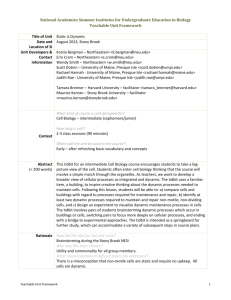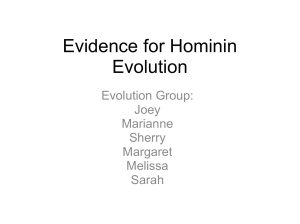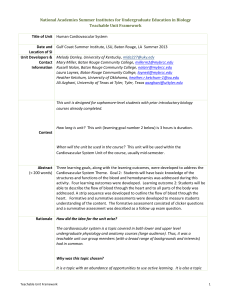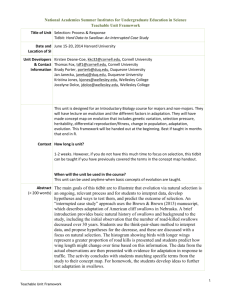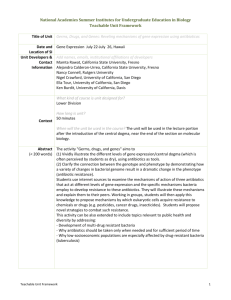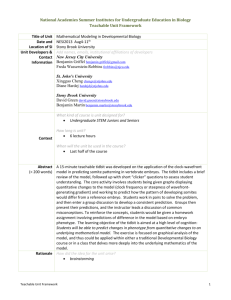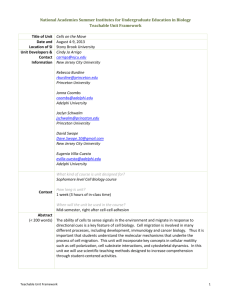Teachable Unit Framework - Sex and Society
advertisement
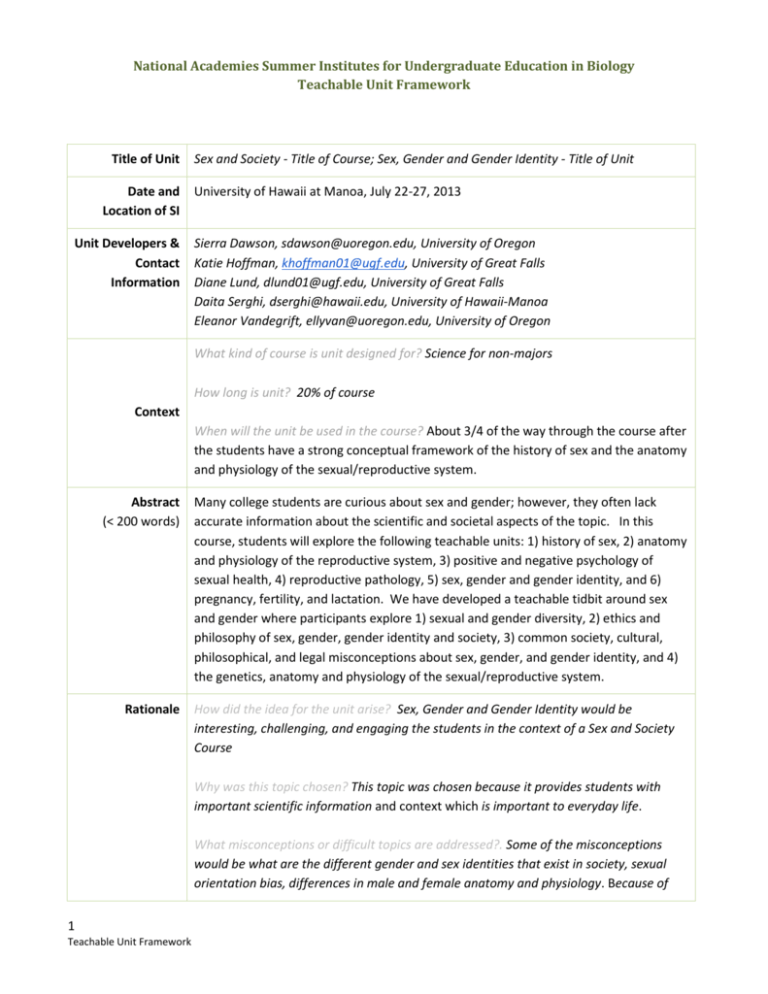
National Academies Summer Institutes for Undergraduate Education in Biology Teachable Unit Framework Title of Unit Date and Location of SI Unit Developers & Contact Information Sex and Society - Title of Course; Sex, Gender and Gender Identity - Title of Unit University of Hawaii at Manoa, July 22-27, 2013 Sierra Dawson, sdawson@uoregon.edu, University of Oregon Katie Hoffman, khoffman01@ugf.edu, University of Great Falls Diane Lund, dlund01@ugf.edu, University of Great Falls Daita Serghi, dserghi@hawaii.edu, University of Hawaii-Manoa Eleanor Vandegrift, ellyvan@uoregon.edu, University of Oregon What kind of course is unit designed for? Science for non-majors How long is unit? 20% of course Context When will the unit be used in the course? About 3/4 of the way through the course after the students have a strong conceptual framework of the history of sex and the anatomy and physiology of the sexual/reproductive system. Abstract (< 200 words) Rationale Many college students are curious about sex and gender; however, they often lack accurate information about the scientific and societal aspects of the topic. In this course, students will explore the following teachable units: 1) history of sex, 2) anatomy and physiology of the reproductive system, 3) positive and negative psychology of sexual health, 4) reproductive pathology, 5) sex, gender and gender identity, and 6) pregnancy, fertility, and lactation. We have developed a teachable tidbit around sex and gender where participants explore 1) sexual and gender diversity, 2) ethics and philosophy of sex, gender, gender identity and society, 3) common society, cultural, philosophical, and legal misconceptions about sex, gender, and gender identity, and 4) the genetics, anatomy and physiology of the sexual/reproductive system. How did the idea for the unit arise? Sex, Gender and Gender Identity would be interesting, challenging, and engaging the students in the context of a Sex and Society Course Why was this topic chosen? This topic was chosen because it provides students with important scientific information and context which is important to everyday life. What misconceptions or difficult topics are addressed?. Some of the misconceptions would be what are the different gender and sex identities that exist in society, sexual orientation bias, differences in male and female anatomy and physiology. Because of 1 Teachable Unit Framework National Academies Summer Institutes for Undergraduate Education in Biology Teachable Unit Framework social taboos around these topics students have a lack of accurate information Learning Goals: what students will know, understand, and be able to do; includes content knowledge, attitudes, & skills By the end of this course/teachable unit students will: 1. understand, empathize, and celebrate sexual and gender diversity 2. examine ethics and philosophy related to sex, gender, and society 3. uncover common societal, cultural, philosophical, legal misconceptions about sex and gender 4. know the genetics, anatomy and physiology of the sexual/reproductive system Learning Outcomes: Student behaviors or performances that will indicate they have successfully accomplished the goals By the end of the teachable unit/tidbit the students will: 1. Be able to distinguish between sex and gender and know in which context each term is appropriate 2. Compare and contrast levels of sexual determination including chromosomal, gonadal, phenotypical, psychological and societal. 3. Critique popular media and societal misrepresentation surrounding sex, gender, gender identity and identify bias 2 Teachable Unit Framework National Academies Summer Institutes for Undergraduate Education in Biology Teachable Unit Framework Incorporation of Scientific Teaching Themes Active Learning Assessment Diversity How students will engage actively in learning the concepts How teachers will measure learning; how students will selfevaluate learning How the unit is designed to include participants with a variety of experiences, abilities, and characteristics `` Activities outside of class: Read article before class about how to most accurately use the terms sex and gender. Activities in class (for tidbit): Group brainstorming "What does it mean to be male?" and "What does it mean to be female?" using large paper post-its. Split the class in half so that each group addresses either male or female. 3-5 minutes; encourage groups to think as broadly as possible. Debrief with whole class pointing out: chromosomal, internal organs, external characteristics, psychological, societal statements. Clicker question with a vote, conversation, and revote: “In which research title is the use of the term gender most ambiguously?”Show results after the revote and debrief. Clarify the use of the terms sex 3 Teachable Unit Framework Pre-assessments: Students will answer the following questions online before class: 1. What is the main distinction between the appropriate use of the terms sex and gender? 2. Come up with 4 research topics with 2 appropriate for each term (sex and gender) Post-tidbit assessments: Take Home Exam: ● Critique use of sex and gender term in written word ● Case study (Olympic Runner) National Academies Summer Institutes for Undergraduate Education in Biology Teachable Unit Framework and gender with .ppt slide (which is based on the reading assignment). Put post-its on the wall and have students move to a different group’s post-it. Have students circle sex characteristics and star gender characteristics. Debrief with entire class regarding what they have circled and starred. Introduce a case study about a Olympic hurdler who was outwardly female but was disqualified from competition on the basis of sex. Think pair share regarding what might have occurred in this case. Debrief with students and share actual case circumstances. Sample Presentation Plan (general schedule with approximate timing for unit) Session 1 Time (min) Learning Outcome(s) Preclass 1 hour Be able to distinguish between sex and gender and know in which context each term is appropriate. 4 Teachable Unit Framework Activity/assessment Explanation, notes, suggestions, tips Students will answer the following questions online before class: article: Torgrimson & Minson, (2005) Sex and Gender: what is the difference. Journal of Applied Physiology. Issue 99. Pgs. 785-787 1. What is the main distinction between the appropriate use of the terms sex and gender? National Academies Summer Institutes for Undergraduate Education in Biology Teachable Unit Framework 2. Come up with 4 research topics with 2 appropriate for each term (sex and gender). Enter approx. class time for learning activity preparatory material presentation Introduction of learning outcomes. Mini lecture to set the roadmap for the day. Compare and contrast levels of sexual determination including chromosomal, gonadal, phenotypical, psychological and societal. Group brainstorming "What does it mean to be male?" and "What does it mean to be female?" using large paper post-its. Split the class in half so that each group addresses either male or female. 3-5 minutes; encourage groups to think as broadly as possible. Debrief with whole class pointing out: chromosomal, internal organs, external characteristics, psychological, societal statements. Bring large post-it paper, and write the question on the post-it ahead of time. Have an additional post-it to record group thoughts during debrief. Be able to distinguish between sex and gender and know in Clicker question with a vote, conversation, and revote: “In which research There is not “right or wrong” answer; it is context specific. Be prepared for a lot of different 3 minutes Enter approx. class time for learning activity #1 10 minutes (3-5 minutes group brainstorm; 5 minutes debreif Enter approx. class time for learning 5 Teachable Unit Framework National Academies Summer Institutes for Undergraduate Education in Biology Teachable Unit Framework activity #2 which context each term is appropriate. 5 minutes title is the use of the term gender most ambiguously?” Show results after the revote and debrief. ideas and discussion. Abmiguity is part of the process of learning to distinguish sex and gender. Clarify the use of the terms sex and gender with .ppt slide (which is based on the reading assignment). Enter approx. class time for learning activity #3 Be able to distinguish between sex and gender and know in which context each term is appropriate Put post-its on the wall: have students move to a different group’s post-it. Have students circle sex characteristics and star gender characteristics. Debrief with entire class regarding what they have circled and starred. Spread papers throughout the room so students have enough space to work. Critique popular media and societal misrepresentation surrounding sex, gender, gender identity and identify bias. Introduce a case study about a Olympic hurdler who was outwardly female, but was disqualified from competition on the basis of sex. Think-pair-share regarding what might have occurred in this case. Debrief with students and share actual case circumstances. Allow students to struggle with challenges with the case study and to brainstorm broadly with ideas. 5 minutes Enter approx. class time for learning activity #4 5 minutes Enter 6 Teachable Unit Framework National Academies Summer Institutes for Undergraduate Education in Biology Teachable Unit Framework approximate time for additional learning activities and associated class Work/prepar atory materials Enter approximate time for postactivity summing up or transition Add additional activities information as needed for the unit. Resources for Teaching the Unit Torgrimson & Minson, (2005) Sex and Gender: what is the difference. Journal of Applied Physiology. Issue 99. Pgs. 785-787 Effectiveness of unit (if you have used it in your own teaching) We have not used this in our own teaching; however, the NASI teaching tidbit went well. Acknowledgements Thank you to facilitators Clarissa Dicks and Nori Yeung for their positive encouragement and support. Thank you to Bill Hoese, Lisa Duich Perry, Mark Speck, Rosalind Billharz, Mary Ellard-Ivey, and Karen Bates (Group 3) and Ken Burtis, Mamta Rawat, Alejandro Calderon-Urrea, Nigel Crawford, Ella Tour and Nancy Connell (Group 6) for their do-si-do feedback. 7 Teachable Unit Framework


